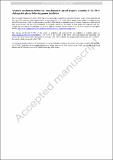Self-healing mechanisms for Ge–Sb–S chalcogenide glasses upon gamma irradiation
Author(s)
Kang, Myungkoo; Sohn, Byoung-Uk; Du, Qingyang; Ma, Danhao; Pujari, Ruturaj; Sisken, Laura; Blanco, Cesar; Goncalves, Claudia; Arias, Chanelle; Zachariou, Anna; Yadav, Anupama; Lynch, Patrick E.; Lee, Jonathan; Novak, Spencer; Schwarz, Casey M.; ... Show more Show less
Download43577_2024_693_ReferencePDF.pdf (1.238Mb)
Open Access Policy
Open Access Policy
Creative Commons Attribution-Noncommercial-Share Alike
Terms of use
Metadata
Show full item recordAbstract
We report atomistic mechanisms that directly correlate the time-dependent optical responses of bulk Ge23Sb7S70 chalcogenide glasses to their metastable structural defects created and subsequently annihilated following gamma irradiation. These defects are characterized by an irradiation-induced increase in the concentration of edge-shared GeS4/2 tetrahedra bonding units, which gradually decreases to a pre-irradiation level during recovery, thus illustrating the glass’ metastable behavior. This time-dependent structural change gives rise to the evolution of the glass’s mass density that correspondingly induces a change and subsequent relaxation of linear refractive index and bandgap energy. Concurrent with this evolution in linear optical properties, the glass’ nonlinear response is found to be unaffected, likely due to a counter effect associated with the glass network’s free electrons. Graphical abstract Impact statement Our work is the first study to employ a combined theoretical-experimental approach to the quantitative processing–structure–property relationship correlating the time-dependent structural and linear/nonlinear optical responses of chalcogenide Ge–Sb–S bulk glasses to their metastable topological coordination defects. These defects are created upon gamma-ray exposure and subsequently undergo relaxation at room temperature. The novelty of our study is that multifaceted aspects of such a key infrared chalcogenide glass, including optical, electronic, morphological, chemical, and microstructural properties, were monitored and cross-correlated as a function of time following gamma irradiation in order to identify origins behind the material system’s behavior as compared to base unirradiated material. This is, to our knowledge, the first-ever integrated approach (summarizing pre- and postexposure properties on the same samples) to the phenomenon. The behavior in metastable bulk chalcogenide glasses serves as a key cornerstone that will enable the material system to be deployed as robust, reversible radiation sensors in extreme environments such as space and ground-based radioactive facilities where gamma ray is characteristically abundant. Findings in our paper may shed light on the lingering question on the microscopic origin behind the self-healing process in chalcogenide glasses.
Date issued
2024-04-17Department
Massachusetts Institute of Technology. Department of Materials Science and EngineeringJournal
MRS Bulletin
Publisher
Springer International Publishing
Citation
Kang, M., Sohn, BU., Du, Q. et al. Self-healing mechanisms for Ge–Sb–S chalcogenide glasses upon gamma irradiation. MRS Bulletin 49, 778–786 (2024).
Version: Author's final manuscript